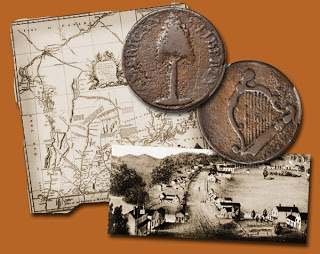
Of all the memorable coins to cross my desk here in my office in the “Live Free or Die” state of New Hampshire – and there have been quite a few rare coins that have passed under my gaze in the past 25 years – perhaps none is more memorable than the 1776 New Hampshire copper that recently sold at our March 2012 Baltimore Auction for a resounding $172,500. Though to some, no doubt, it is a nondescript little piece of flawed copper, its importance in numismatics is as meaningful as the rarity of the piece itself, it being one of just a dozen or so examples of the type thought to exist.
The 1776 New Hampshire copper was first brought to light by Matthew A. Stickney, an early American numismatist whose visit to the Mint in 1843 resulted in a swap of several of his own rare pieces for a Class I “original” 1804 silver dollar, thus enlightening the numismatic community to the existence of that rare delicacy now known as “The King of American Coins.” The New Hampshire copper then went on to bigger and better things, first illustrated in Dr. Montroville W. Dickeson’s 1859 American Numismatical Manual, and then gathering more fame after being illustrated in Sylvester Crosby’s monumental 1875 Early Coins of America. Indeed, the coin was so rare at the time that Stickney considered it one of the three rarest coins he owned – and he owned an 1804 dollar!
The 1776 New Hampshire copper represents the first of the state coinages. Connecticut offered a much broader and more widespread state coinage, 1785 through 1788, with New Jersey following in 1786-1788, and Massachusetts in 1787-1788; the Republic of Vermont, not a state until 1791, issued its own coppers 1785-1788. The New Hampshire copper is, hands down, the rarest of all state coinages. True, there are varieties among the Connecticut, New Jersey, and Massachusetts copper issues that are rarer, in some instances with just one specimen known, but those are die varieties within a larger series where thousands upon thousands of other specimens are known. With the New Hampshire coinage, there are not thousands of pieces to pick from, just a dozen or so, and “pick from” is just wishful thinking, as New Hampshire coppers seldom come into the numismatic marketplace. Indeed, two of the dozen known examples are permanently impounded in museum collections.
The coinage of the New Hampshire coppers was laid at the feet of one William Moulton, of whomvery little is actually known, and was no doubt limited to a few score or more specimens that found their way to various legislators and eventually into pocket change, for the known examples all show some degree of wear and/or minor surface problems. The specimen that Stack’s Bowers Galleries sold in Baltimore is one of the few to come to light in recent times – indeed, it was out of the marketplace for 30 years – and its record price of $172,500 will stand for a long time as a tribute to the rarity and desirability of these little pieces of New Hampshire copper, born in the same year our nation was born.





